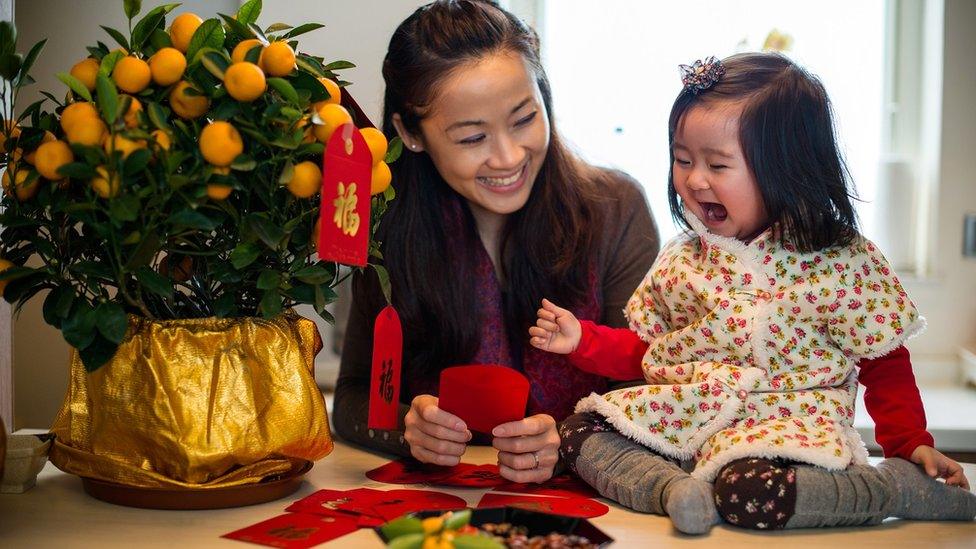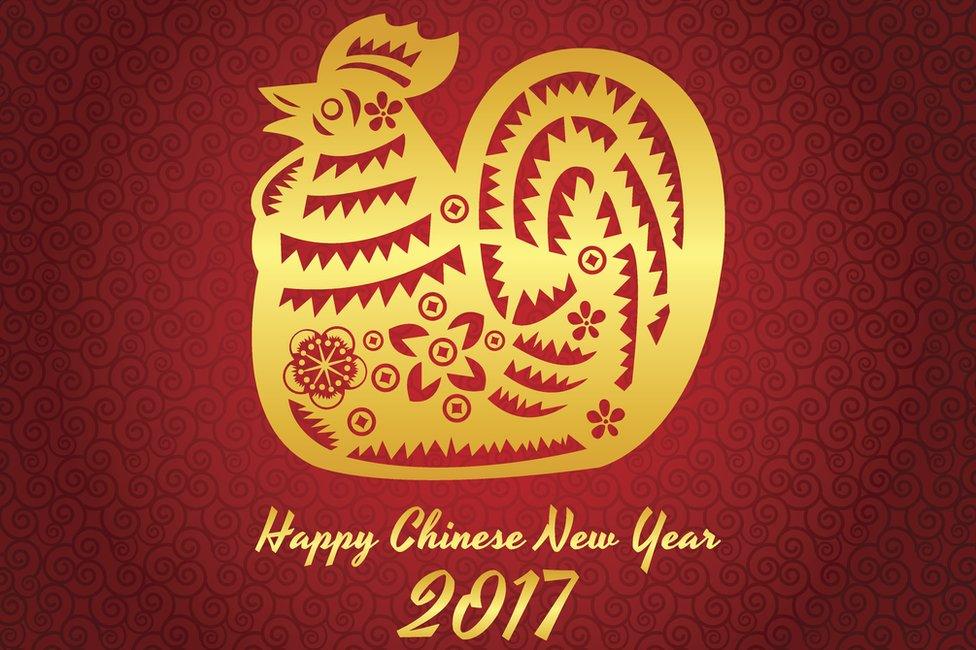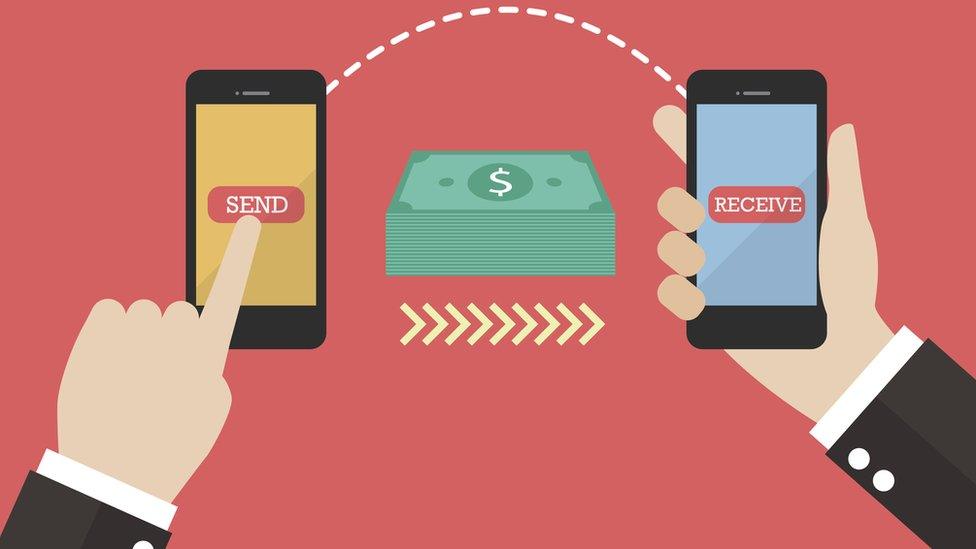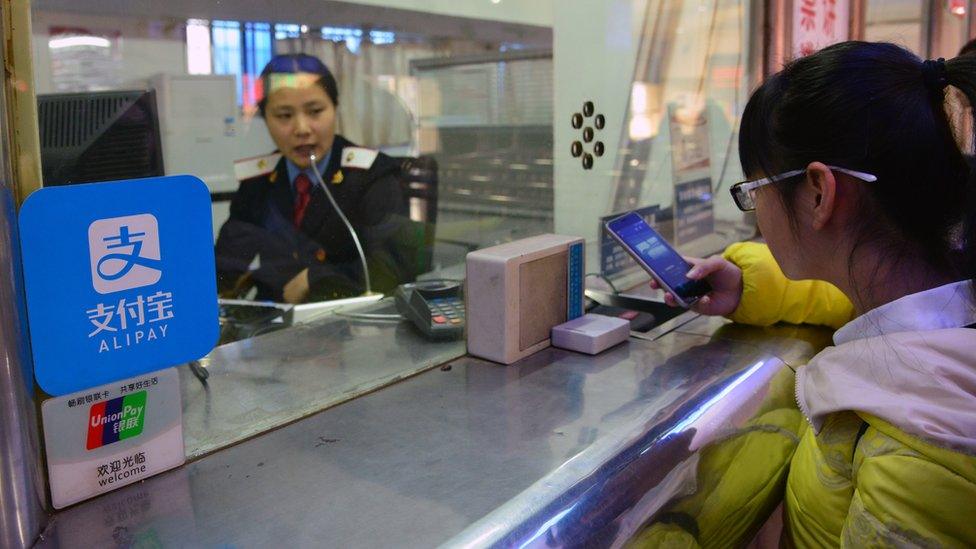Why this Chinese New Year will be a digital money fest
- Published

Are the traditional red envelope gifts at Chinese New Year being replaced by digital versions?
Over this weekend's Chinese New Year celebrations, millions of people will give each other cash-filled red envelopes, called hongbao in Mandarin.
But this year, a record number of these red envelopes will be digital and sent online over social messaging services such as Tencent's WeChat, usually via smartphone.
The numbers are breathtaking.
Over the six-day Chinese Spring Festival period last year, 516 million people sent and received 32 billion digital red envelopes - 10 times the number as over the same period in 2015.
And this year forecasters are expecting up to 100 billion digital envelopes to be sent and received by Chinese well-wishers around the world.
It's a vivid illustration of how the world of money is changing, given that we can now send money to each other as easily as sending an email or text.
Global research firm Ovum thinks the value of these mobile peer-to-peer (P2P) payments could top $270bn (£214bn) worldwide in 2019.

2017 is the Chinese Year of the Rooster
So why is sending money this way proving so popular, particularly among younger people?
"Social messaging has become the defining app of the smartphone era," says Jeremy Allaire, chief executive of P2P payments app, Circle Pay.
"Social payments has been a natural extension of this phenomenon - it's going to be the locus of most communications activity."
Paying somebody by text is quick and easy, removing the hassle of having to go out to a cash machine and hand over money in person. All you usually need is their mobile phone number or email address.
Even if they haven't yet downloaded the app they receive a message telling them money is waiting for them once they've registered.
Whether you're splitting a dinner bill between friends, contributing to shared household costs, or simply sending a gift, payment apps offer convenience within an encrypted, secure environment.
And the fact that these payment apps can sit within messaging apps means you can settle bills without even interrupting your group chat.

Circle Pay's Jeremy Allaire thinks social messaging and payments are the future
The Chinese social media platforms operated by the tech giants Alibaba, Tencent and Baidu have spearheaded the social payments explosion in Asia.
While in the US, PayPal-owned Venmo has been growing at a phenomenal pace and looks set to reach about $20bn in annual transaction volume this year. In Africa, M-pesa has blazed a trail and is also now available in India.
Facebook Messenger, which now claims to have more than one billion users globally, has been offering in-app payments since 2015 in the US, but is now poised to expand the service throughout Europe after acquiring the relevant "e-money" banking licenses.
"There's an opportunity to create the WhatsApp of payments and to make this work globally," says Mr Allaire, whose payment service is also available within the Apple iMessage app.
He envisages a world in which there are no barriers to sending money anywhere.

Young people in particular are happy to use their phones as digital wallets
"I can send and receive content instantly for free, by text, email and video - so why can't I do the same with money? It's just data and software," he says.
Circle's service is built on crypto currency Bitcoin's blockchain system, which enables transactions to be verified and completed quickly and securely, even across borders.
And it is this crossborder facility that offers great potential, Mr Allaire believes, largely because banks tend to charge far more than P2P platforms.
"I can beam money to my kids wherever they happen to be in the world at a cost of 0.3%, whereas banks will typically charge 3%," he says.
But smartphones have been around for nearly a decade, so what has changed to explain this sudden surge in the popularity of social payments?
"The regulatory environment improved," says James Morton, head of UK and Netherlands for Mangopay, a P2P payments platform powering several other apps, such as Pumpkin.

Are we entering the era of low-cost borderless money transfers?
"To hold client money you have to be regulated, which was a big hurdle to overcome. And the payments infrastructure was quite archaic, working only from bank to bank with a complex structure of issuers, acquirers and processors - it was a very manual process."
Allowing firms to become "e-money issuers" opened the door to tech companies to automate a lot of these background processes, including the authentication, data protection and money laundering requirements imposed by regulators.
An international bank-to-bank money transfer, external can still take days to clear - despite efforts to introduce faster payments - whereas P2P payments can be completed in seconds.
And now that younger generations trust the security of their apps and phones - verifying transactions by fingerprint or even facial recognition - P2P service providers are interposing themselves between banks and acting as money repositories themselves.
For example, Venmo enables its 12 million users to load their Venmo accounts with money and use this fund to pay other people and make in-app purchases.

A Chinese student returning home for the Spring Festival pays her fare using the Alipay app
Chinese networks Alipay and WeChat allow users to pay utility bills from their accounts.
They can also transfer money back to their main bank account within a business day. It's the kind of service PayPal already offers for its customers through its PayPal.me service.
"If you look at how the gig and sharing economy is growing, I think payments infrastructure will remove the necessity for having your bank debit account for anything other than paying bills," says Mr Morton.
New P2P payment providers have sprung up all over the place: Square Cash, FaceCash Payfriendz, TransferWise, the relaunched Google Wallet, People Pay, Popmoney, Snapcash, Dwolla - the list goes on.
Not that the big banks are twiddling their thumbs while tech upstarts steal their business.
In the US, a company called Early Warning, which is owned by big names such as Bank of America, JP Morgan Chase and Wells Fargo, has set up a P2P payments business called ClearXchange with access to more than 100 million customers.
All you need to send money to someone else's bank account for free is their email address or mobile phone number, much like the UK's PayM system.
Card issuers Visa and Mastercard have joined up with ClearXchange to allow people to make P2P payments via their MasterCard Send and Visa Direct platforms.
These are exciting times in the world of P2P payments - more competition, more convenience, lower costs.
But in the Chinese Year of the Rooster, it remains to be seen whether a digital red envelope will bring as much luck and good fortune as the traditional paper one.
Follow Matthew on Twitter, external and Facebook, external